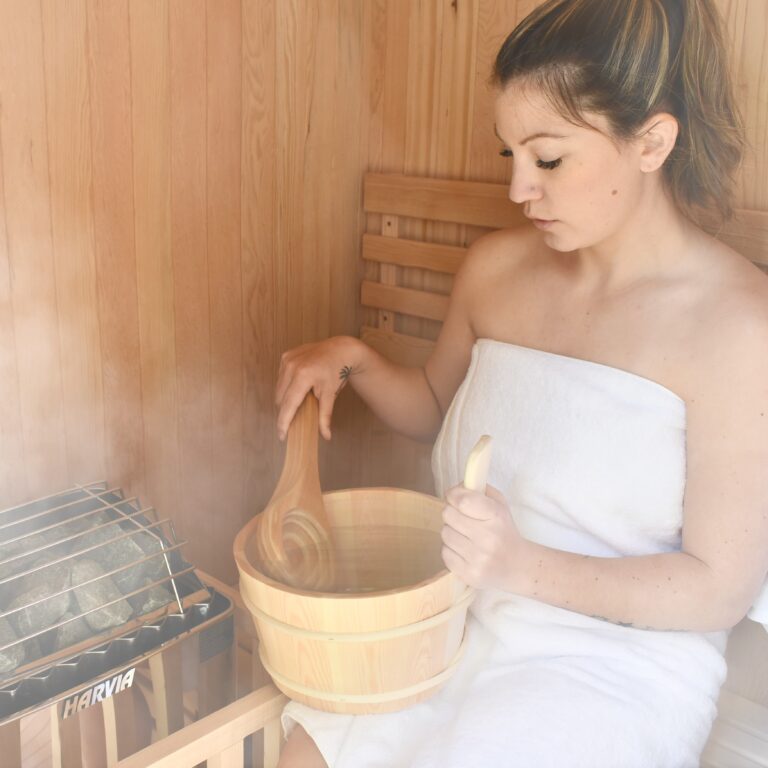
Dry Sauna VS Wet Sauna Which One?
In this guide to wet sauna vs dry sauna, we'll look at the health benefits of each and what to consider if you want a sauna for your home. What Is a Dry Sauna? A dry sauna is probably what you picture when you think of a regular sauna: a small room lined with wood, an electric stove or heater situated inside, perhaps with some hot rocks on.

Dry Sauna vs. Wet Sauna What's the Difference?
A wet sauna, on the other hand, is recommended for those who are stressed and need to reduce their stress. A dry sauna is recommended for people who want to relieve stress and anxiety. The warm air penetrates the body quickly, while a wet sauna can induce sweating. A wet sauna is more beneficial for reducing blood pressure.

Sauna vs Steam Room (Dry Heat vs Moist Heat) Sauna Samurai
Benefits Dry saunas are quintessential saunas that are made as a plain, wooden rooms with modern electric heating or wood burning stoves. The dry heat makes you sweat as well. However, you perspire much more in a dry sauna than in a wet sauna.

In the sauna vs steam room debate, see the difference between dry heat
In a dry sauna, the air is heated without added humidity, leading to an intense, dry heat that encourages profuse sweating. This environment is beneficial for those looking to relax their muscles, improve circulation, and potentially relieve stress. On the other hand, a wet sauna, often referred to as a steam room, introduces high humidity with.

Dry Sauna VS Wet Sauna Which One?
The most apparent difference between a dry sauna and a wet sauna is the method of heating. A dry sauna heats the air to a high temperature, usually ranging from 160-200°F, using electric stoves or wood fires, and allows humidity levels to stay low.

Dry vs. Wet Sauna Everything You Need to Know SaunaGenius
Dry Sauna vs. Wet Sauna: What's the Difference? Chris Deziel Updated: Apr. 26, 2023 mgstudyo/Getty Images Dry saunas have been around for thousands of years. Steam makes the wet sauna experience more luxurious but reduces the health benefits. Most people think of Finland when they think of saunas. After all, the word "sauna" is Finnish.

Dry Sauna vs. Wet Sauna What's the Difference? ALEKO
Dry Sauna VS Wet Sauna: Which One? Saunas are classified into two categories, which are the dry and wet saunas. The dry saunas are crucial for relaxing the body because they produce dry steam that heats your body hence facilitating it to sweat and release fatigue.

Dry Sauna vs. Wet Sauna What's the Difference? ALEKO
The heat is usually much more tolerable in a dry sauna than in a wet sauna because the heat reaches your body more quickly. Wet saunas take a little longer for your body to feel the effects of the heat and are much more humid. However, what you wear in a sauna can also affect how you feel, especially if there is high humidity.

Dry vs. Wet Sauna What's the Difference?
A dry sauna is an enclosed chamber that's usually made of wood, typically cedar. The average sauna temperature is between 68 and 158 degrees—but can go up to 195 degrees, depending on the model, user, and venue (such as the gym or your favorite spa). Generally, the humidity in dry saunas hovers between 10 and 20%.

Dry vs. Wet Sauna What's the Difference? (2022)
But what are the differences between them? And which one is the best for you? Dry saunas use dry heat, either from infrared rays in an infrared sauna or an electric or wood-fired sauna heater, to raise your body temperature. Wet saunas, on the other hand, use steam to increase the humidity of the air, which can make the heat feel more intense.

Wet Sauna vs Dry Sauna The Biggest Differences
Dry Saunas: Benefits and Comparison with Steam Rooms, Infrared Health Benefits of Dry Saunas, and How they Compare to Steam Rooms and Infrared Saunas Benefits Vs. steam rooms.

One infographic to know about dry sauna and wet steam appollobath
A wet sauna is a variation of the traditional sauna experience, incorporating both dry heat and steam. At its essence, a wet sauna uses a heat source, usually hot rocks or a closed stove, similar to a dry sauna. In a wet sauna, the atmosphere is heavy with moisture, with humidity levels often soaring above 50%. This high humidity makes sweat.

Wet Sauna vs Dry Sauna, Mana yang Bagus untuk Kesehatan?
Key Takeaways: Wet saunas pour water over heated rocks, creating steam, while dry saunas rely on heated bare stones without water. Wet saunas are believed to eliminate toxins from the body and reduce the chances of illnesses, while dry saunas are known for relieving stress, improving skin, and stimulating blood circulation.

Wet Sauna vs. Dry Sauna — What’s the Difference
Dry Sauna vs Wet Sauna: Which is Better for You? Discover the benefits of dry and wet saunas and find out which one is right for you. Learn about their differences and make an informed decision. Discover the benefits of dry and wet saunas and find out which one is right for you. Learn about their differences and make an informed decision.

The Benefits Of A Dry Sauna Vs. Wet Sauna What To Know Before
Dry vs. Wet Sauna: What's the Difference? By Emma (Sunrise Specialty Staff) Saunas are an excellent way to relax, and they also have many proven - as well as suspected - health benefits. However, there's more than one type of sauna, and the advantages and disadvantages are not quite the same from one to the next.

Traditional or Infrared, Sauna or Steam Room; What’s the Difference
The temperature in a wet sauna is different from that in a dry sauna. In a dry sauna, temperatures normally range anywhere from 160 ºF to 200 ºF, with the absolute maximum temperature being 212 ºF. A wet sauna, on the other hand, ranges between 110 - 120 ºF. It is important to note that even though wet saunas are at a much lower.